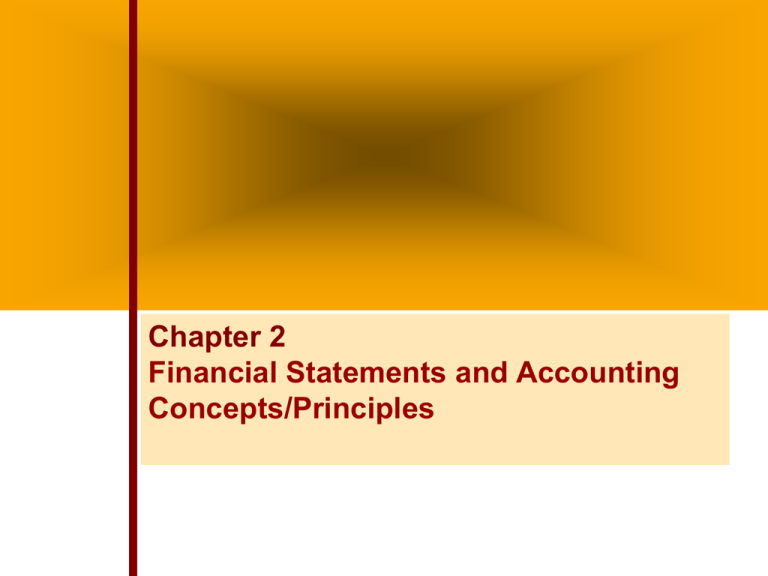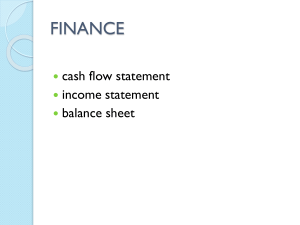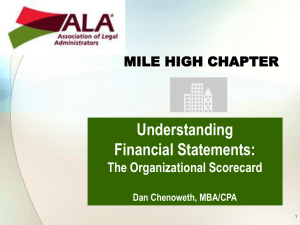
1-1
2-1
© 2008 The McGraw-Hill Companies, Inc., All Rights Reserved.
Chapter 2
Financial Statements and Accounting
Concepts/Principles
McGraw-Hill/Irwin
2-1
© 2008 The McGraw-Hill Companies, Inc., All Rights Reserved.
1-2
2-2
Financial Statements
LO1
Transactions are economic
interchanges between entities
that are accounted for and
reflected in financial statements.
McGraw-Hill/Irwin
2-2
© 2008 The McGraw-Hill Companies, Inc., All Rights Reserved.
1-3
2-3
Accounts
LO1
Transactions are
summarized in accounts.
Cash
Accounts
Receivable
Accounts
Payable
McGraw-Hill/Irwin
Accounts are used to
organize like-kind
transactions.
Account balances are then
used in the preparation of
financial statements.
2-3
© 2008 The McGraw-Hill Companies, Inc., All Rights Reserved.
1-4
2-4
LO2
Financial Statements
Required Disclosure
Financial position at the
end of the period
Earnings for the period
Cash flows during the
period
Investments by and
distributions to owners
during the period
Financial Statement that
Satisfies Requirement
Balance Sheet
Income Statement
Statement of Cash Flows
Statement of Changes in
Owners' Equity
In addition to the financial statements, the annual report will
probably include several accompanying notes or
explanations of the accounting policies used and detailed
information about many of the amounts and captions shown
in the financial statements.
2-4
McGraw-Hill/Irwin
© 2008 The McGraw-Hill Companies, Inc., All Rights Reserved.
1-5
2-5
Balance Sheet-Elements
LO3
Assets represent the amount of resources
owned by the entity.
Main Street Store, Inc.
Balance Sheet
August 31, 2014
Assets
Current Assets
Cash
Accounts receivable
Merchandise inventory
Total current assets
Plant and Equipment
Equipment
Less: Accumulated
depreciation
Total assets
McGraw-Hill/Irwin
$
$
$
40,000
Liabilities and Owners' Equity
Current Liabilities
Short-term debt
$
20,000
Accounts payable
35,000
Other accrued liabilities
12,000
Total current liabilities
$
67,000
Long-term debt
50,000
Total liabilities
117,000
(4,000)
Owners' equity
34,000
80,000
170,000
284,000
320,000
Total liabilities and
owners' equity
203,000
$
320,000
Liabilities are
amounts owed
to other entities.
Equity is the
ownership right
of the owner(s) of
the entity in the
assets that
remain after
deducting the
liabilities.
2-5
© 2008 The McGraw-Hill Companies, Inc., All Rights Reserved.
1-6
2-6
Balance Sheet
LO3
Current assets are those assets that are likely to be converted into
cash or used to benefit the entity within one year.
Assets
Current Assets
Cash
Accounts receivable
Merchandise inventory
Total current assets
Plant and Equipment
Equipment
Less: Accumulated
depreciation
Total assets
McGraw-Hill/Irwin
Main Street Store, Inc.
Balance Sheet
August 31, 2014
Liabilities and Owners' Equity
Current Liabilities
$
34,000 Short-term debt
$
20,000
80,000 Accounts payable
35,000
170,000 Other accrued liabilities
12,000
$
284,000 Total current liabilities
$
67,000
Long-term debt
50,000
40,000 Total liabilities
117,000
(4,000) Owners' equity
203,000
$
320,000
Total liabilities and
owners' equity
$
320,000
2-6
Current
liabilities
are those
liabilities
that are to
be paid
within
one year.
© 2008 The McGraw-Hill Companies, Inc., All Rights Reserved.
1-7
2-7
Balance Sheet
LO3
Assets
=
Liabilities
+
Equity
Main Street Store, Inc.
Balance Sheet
August 31, 2014
Assets
Current Assets
Cash
Accounts receivable
Merchandise inventory
Total current assets
Plant and Equipment
Equipment
Less: Accumulated
depreciation
Total assets
McGraw-Hill/Irwin
$
$
34,000
80,000
170,000
284,000
40,000
(4,000)
$
320,000
Liabilities and Owners' Equity
Current Liabilities
Short-term debt
$
20,000
Accounts payable
35,000
Other accrued liabilities
12,000
Total current liabilities
$
67,000
Long-term debt
50,000
Total liabilities
117,000
Owners' equity
Total liabilities and
owners' equity
203,000
$
2-7
320,000
© 2008 The McGraw-Hill Companies, Inc., All Rights Reserved.
1-8
2-8
LO4
Income Statement
The income statement shows the profit (or loss) for the
period of time under consideration.
Revenues result from
the entity’s operating
activities (e.g., selling
merchandise).
Costs and expenses
are incurred in
generating revenues
and operating the
entity.
Main Street Store, Inc.
Income Statement
For the Year Ended August 31, 2014
Net sales
Cost of goods sold
Gross profit
Selling, general, and admin. expenses
Income from operations
Interest expense
Income before taxes
Income taxes
Net income
Earnings per share of common stock
outstanding
$
$
1,200,000
850,000
350,000
311,000
39,000
9,000
30,000
12,000
18,000
$
1.80
$
$
$
Gains and losses are also reported on the income statement and result from nonoperating activities, rather than from the day-to-day operating activities that
2-8
generate
revenues and expenses.
McGraw-Hill/Irwin
© 2008 The McGraw-Hill Companies, Inc., All Rights Reserved.
1-9
2-9
LO4
Statement of Changes
in Owners’ Equity
Main Street Store, Inc.
Statement of Changes in Owners' Equity
For the Year Ended August 31, 2014
Paid-In Capital:
Beginning balance
Common stock, par value $10; 50,000 shares
authorized, 10,000 shares issued and
outstanding
Additional paid-in capital
Balance, August 31, 2014
Retained Earnings:
Beginning balance
Net income for the year
Less: Cash dividends of $.50 per share
Balance, August 31, 2014
Total owners' equity
$
$
$
$
$
-
100,000
90,000
190,000
18,000
(5,000)
13,000
203,000
This financial statement shows the detail of owners’
equity and explains the changes that occurred in the
components of owners’ equity during the year.
2-9
McGraw-Hill/Irwin
© 2008 The McGraw-Hill Companies, Inc., All Rights Reserved.
1-10
2-10
Statement of Cash Flows
LO4
Main Street Store, Inc.
Statement of Cash Flows
For the Year Ended August 31, 2014
Cash Flows from Operating Activities:
Net income
$
18,000
Add (deduct) items not affecting cash:
Depreciation expense
4,000
Increase in accounts receivable
(80,000)
Increase in merchandise inventory
(170,000)
Increase in current liabilities
67,000
Net cash used by operating activities
(161,000)
Cash Flows from Investing Activities:
Cash paid for equipment
$
(40,000)
Cash Flows from Financing Activities:
Cash received from issue of long-term debt
50,000
Cash received from sale of common stock
190,000
Payment of cash dividend on common stock
Net cash provided by financing activities
Net increase in cash for the year
McGraw-Hill/Irwin
The purpose of this
financial statement
is to identify the
sources and uses of
cash during the
year.
(5,000)
$
235,000
$
34,000
2-10
© 2008 The McGraw-Hill Companies, Inc., All Rights Reserved.
1-11
2-11
LO4
Financial Statement Relationships and
the Accounting Equation
If assets equal $300,000 and liabilities equal $125,000, what is owners’
equity?
Balance Sheet
Assets
= Liabilities
300,000 = 125,000
Owners'
+ Equity
+ 175,000
Owners’ equity equals $175,000
($300,000 - $125,000)
Now, suppose that total assets increase $12,000 during the year and total
liabilities decrease $3,000 during the year.
Balance Sheet
Assets
=
300,000
12,000
312,000
McGraw-Hill/Irwin
Liabilities +
125,000
(3,000)
122,000
Owners'
Equity
175,000
15,000
190,000
Owners’ equity must have increased by
$15,000. Since owners’ equity was
$175,000 at the beginning of the year, it
must be $190,000 at the end of the
year.
2-11
© 2008 The McGraw-Hill Companies, Inc., All Rights Reserved.
1-12
2-12
Balance Sheet
LO4
Account
Definition
Cash
Cash on hand and in the bank
Accounts receivable
Amounts due from customers
Merchandise inventory
Cost of merchandise acquired and not yet sold
Equipment
Cost of equipment purchased and used in business
Accumulated depreciation Portion of the cost of equipment that is estimated to have
been used up in the process of operating the business
Short-term debt
Amounts borrowed that will be repaid within one year of the
balance sheet date
Accounts payable
Amounts due to suppliers
Other accrued liabilities
Amounts owed to various creditors
Long-term debt
Amounts borrowed from banks or other creditors that will
not be repaid within one year from the balance sheet date
Owners' equity
Residual claim of owners, computed as "assets minus
liabilities"
McGraw-Hill/Irwin
2-12
© 2008 The McGraw-Hill Companies, Inc., All Rights Reserved.
1-13
2-13
LO4
Income Statement
Captions
Net sales
Cost of goods sold
Gross profit
Selling, general, and
administrative expenses
Income from operations
Interest expense
Income taxes
Net income per share of
common stock
outstanding
McGraw-Hill/Irwin
Explanation
Amount of sales of merchandise to customers, less the
amount of customer returns of merchandise
Represents the total cost of merchandise removed from
inventory and delivered to customers as a result of sales
Difference between net sales and cost of goods sold;
Represents the seller's maximum amount of "cushion"
from which all other expenses of the business must be
deducted before it is possible to have net income
Represents the operating expenses of the entity
Represents one of the most important measures of the
firm's activities
Represents the cost of using borrowed funds
Shown after all of the other income statement items have
been reported because income taxes are a function of the
firm's income before taxes
A significant item in evaluating the market value of a share
of common stock; Often referred to as "earnings per
share" or EPS
2-13
© 2008 The McGraw-Hill Companies, Inc., All Rights Reserved.
1-14
2-14
Statement of Changes
in Owners’ Equity
LO4
Captions
Paid-in capital
Common stock
Additional paid-in capital
Explanation
Represents the total amount invested in the entity by
the owners
Reflects the number of shares authorized by the
corporation's charter, the number of shares issued to
stockholders, and the number of shares still held by
the stockholders
Difference between the total amount invested by the
owners and the par value or stated value of the stock
Retained earnings
Represents the cumulative net income of the entity
that has been retained for use in the business
Dividends
Distributions of earnings to the owners
McGraw-Hill/Irwin
2-14
© 2008 The McGraw-Hill Companies, Inc., All Rights Reserved.
1-15
2-15
LO4
Statement of Cash Flows
Captions
Explanation
Cash flows from operating Shown first; Net income is the starting point for this
activities
measure of cash generation
Depreciation expense
Added back to net income because it is subtracted to
arrive at net income, but does not require the use of cash
Increase in accounts
receivable
Increase in merchandise
inventory
Increase in current
liabilities
Deducted because it reflects sales revenues, included in
net income, but not yet received in cash
Deducted because cash was spent to acquire the
increase in inventory
Added because cash has not yet been paid for the
products and services that have been received during the
current fiscal period
Cash flows from investing Shows the cash sources and uses related to long-lived
activities
assets
Cash flows from financing Shows the cash sources and uses related to transactions
activities
with creditors and stockholders
McGraw-Hill/Irwin
2-15
© 2008 The McGraw-Hill Companies, Inc., All Rights Reserved.
1-16
2-16
LO6
Accrual Accounting Vs. Cash Flows
Revenue Recognition -Timing is the Key
Accrual accounting
recognizes:
Cash flow
recognizes:
Revenue
Revenue
when revenue is earned,
at the point of sale of
services or products.
when payment is received
for services rendered
or products sold.
Expenses
Expenses
when they are incurred.
when they are paid.
McGraw-Hill/Irwin
2-16
© 2008 The McGraw-Hill Companies, Inc., All Rights Reserved.









